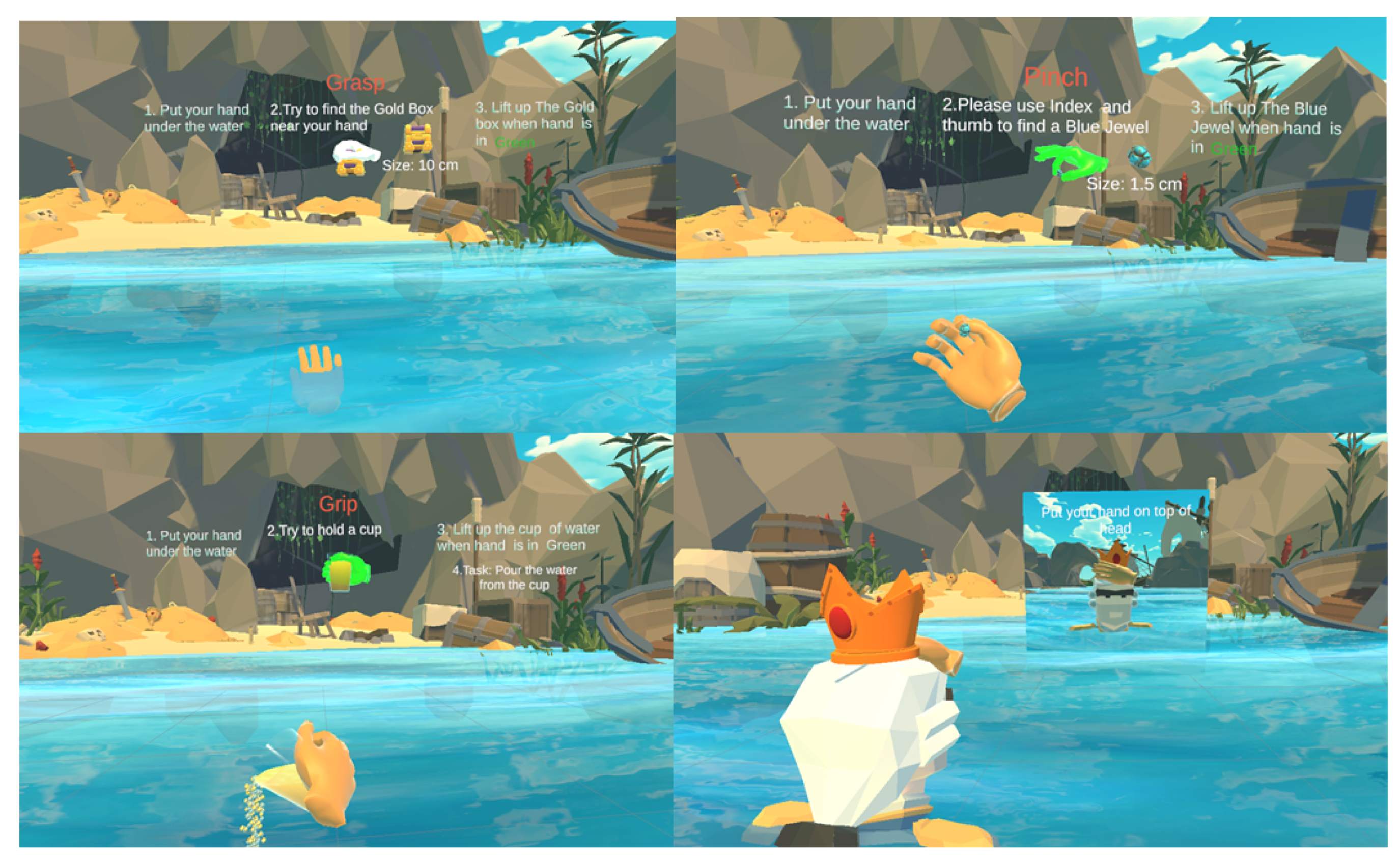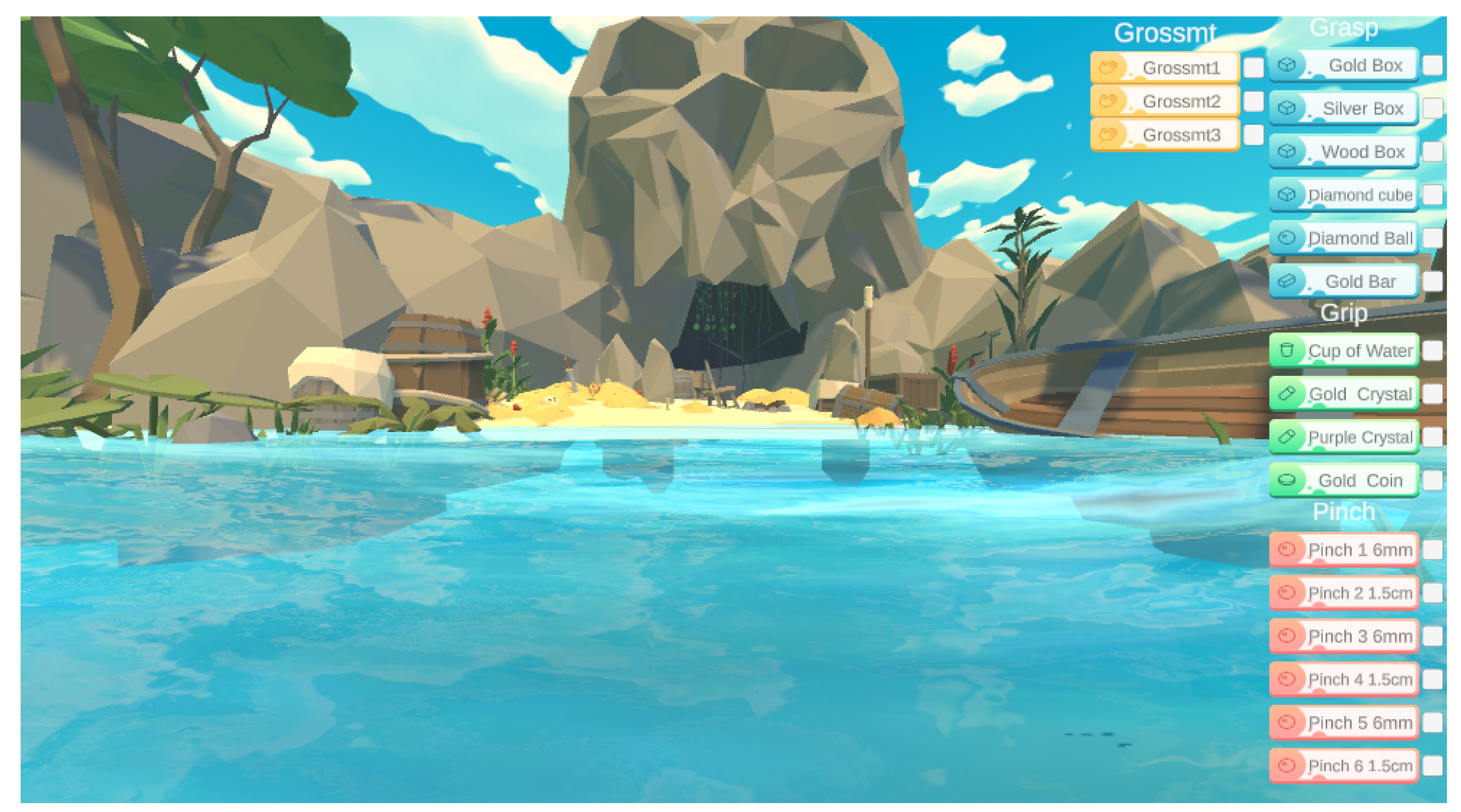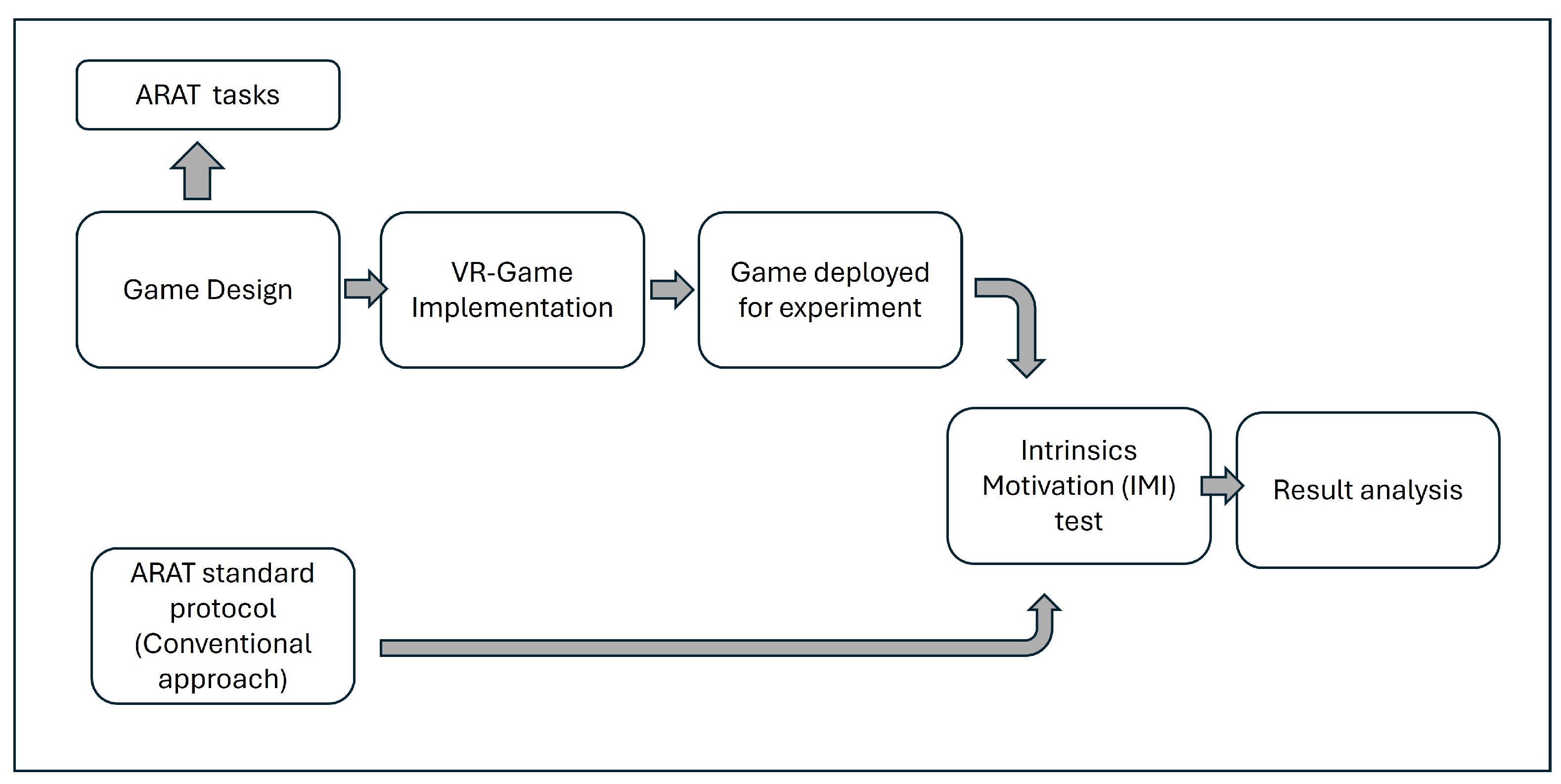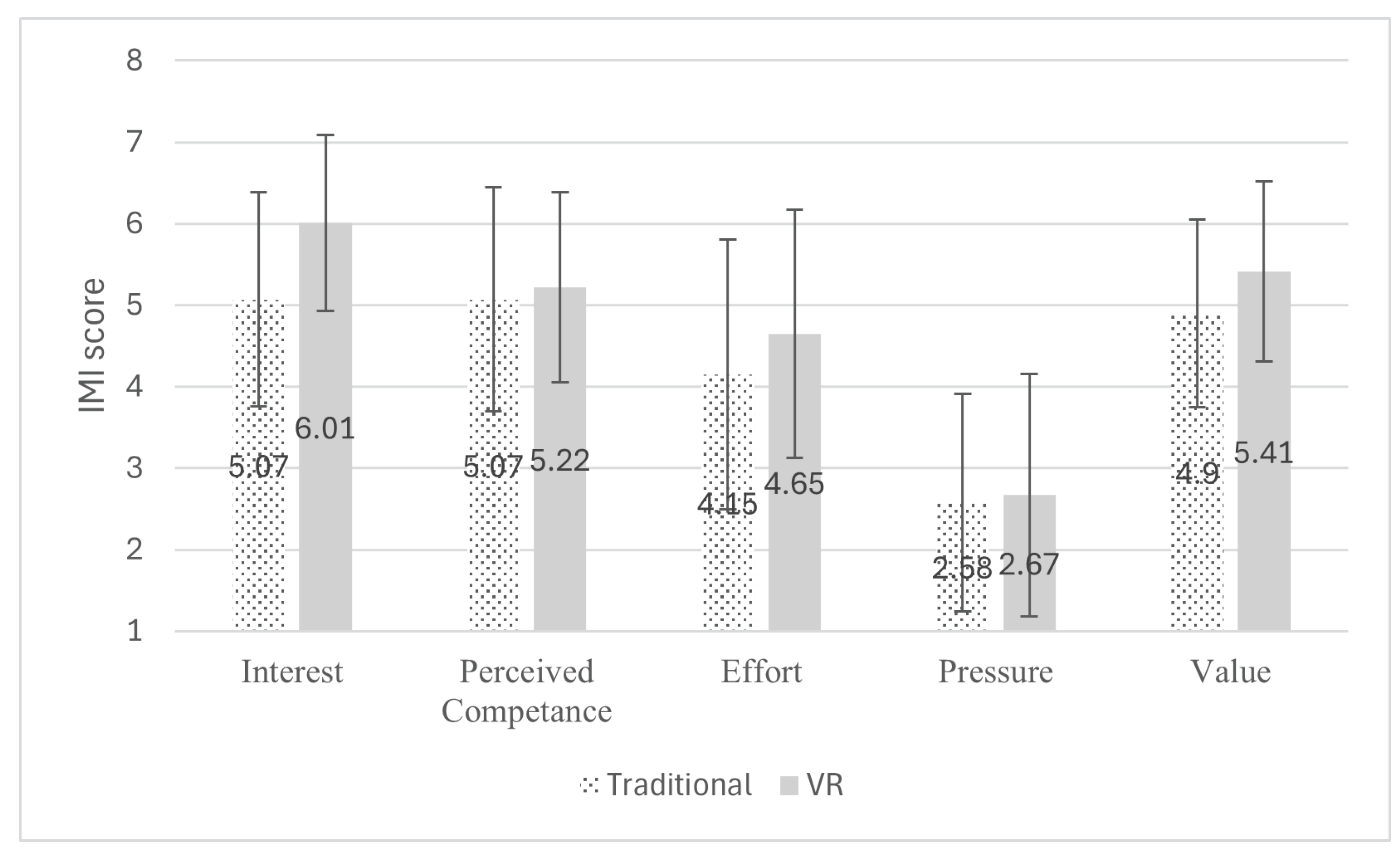The Impacts of Incorporating Virtual Reality and Data Gloves in Exergames on Intrinsic Motivation in Upper-Extremity Assessments: A Study in a Young and Healthy Group
Abstract
1. Introduction
2. Methods
2.1. Devices
2.2. Action Research Arm Test (ARAT)
2.3. Game Development
Game Design for UE Assessment
2.4. Intrinsic Motivation Inventory (IMI)
- I enjoyed doing this activity very much.
- This activity was fun to do.
- I thought this was a boring activity (R).
- This activity did not hold my attention at all (R).
- I would describe this activity as very interesting.
- I thought this activity was quite enjoyable.
- While I was doing this activity, I was thinking about how much I enjoyed it.
2.5. Research Methodology
2.6. Evaluation and Data Collection
3. Results
3.1. Demographics
3.2. Intrinsic Motivation
4. Discussion
Author Contributions
Funding
Institutional Review Board Statement
Informed Consent Statement
Data Availability Statement
Conflicts of Interest
References
- Berg, L.P.; Vance, J.M. Industry use of virtual reality in product design and manufacturing: A survey. Virtual Real. 2017, 21, 1–17. [Google Scholar] [CrossRef]
- Biocca, F.; Delaney, B. Immersive virtual reality technology. Commun. Age Virtual Real. 1995, 15, 10–5555. [Google Scholar]
- Ryan, M.L. Narrative as Virtual Reality Narrative as Virtual Reality: Immersion and Interactivity in Literature and Electronic Media; Johns Hopkins University Press: Baltimore, MD, USA, 2000; pp. 357–359. ISBN 0801864879. [Google Scholar]
- Rose, T.; Nam, C.S.; Chen, K.B. Immersion of virtual reality for rehabilitation-Review. Appl. Ergon. 2018, 69, 153–161. [Google Scholar] [CrossRef] [PubMed]
- Gregg, L.; Tarrier, N. Virtual reality in mental health: A review of the literature. Soc. Psychiatry Psychiatr. Epidemiol. 2007, 42, 343–354. [Google Scholar] [CrossRef]
- Javaid, M.; Khan, I.H. Virtual reality (VR) applications in cardiology: A review. J. Ind. Integr. Manag. 2022, 7, 183–202. [Google Scholar] [CrossRef]
- Schiza, E.; Matsangidou, M.; Neokleous, K.; Pattichis, C.S. Virtual reality applications for neurological disease: A review. Front. Robot. 2019, 6, 100. [Google Scholar] [CrossRef]
- Savickaite, S.; McDonnell, N.; Simmons, D. Defining virtual reality (VR). Scoping literature review on VR applications in autism research. PsyArXiv 2022. [Google Scholar] [CrossRef]
- World Health Organization Rehabilitation. 2024. Available online: https://www.who.int/news-room/fact-sheets/detail/rehabilitation (accessed on 18 October 2024).
- Mazurek, J.; Kiper, P.; Cieślik, B.; Rutkowski, S.; Mehlich, K.; Turolla, A.; Szczepańska-Gieracha, J. Virtual reality in medicine: A brief overview and future research directions. Hum. Mov. 2019, 20, 16–22. [Google Scholar] [CrossRef]
- Gumaa, M.; Rehan Youssef, A. Is virtual reality effective in orthopedic rehabilitation? A systematic review and meta-analysis. Phys. Ther. 2019, 99, 1304–1325. [Google Scholar] [CrossRef]
- Parsons, T.D.; Rizzo, A.A.; Rogers, S.; York, P. Virtual reality in paediatric rehabilitation: A review. Dev. Neurorehabilit. 2009, 12, 224–238. [Google Scholar] [CrossRef]
- Pereira, M.F.; Prahm, C.; Kolbenschlag, J.; Oliveira, E.; Rodrigues, N.F. Application of AR and VR in hand rehabilitation: A systematic review. J. Biomed. Inform. 2020, 111, 103584. [Google Scholar] [CrossRef] [PubMed]
- Larson, E.B.; Feigon, M.; Gagliardo, P.; Dvorkin, A.Y. Virtual reality and cognitive rehabilitation: A review of current outcome research. NeuroRehabilitation 2014, 34, 759–772. [Google Scholar] [CrossRef] [PubMed]
- De Araújo, A.V.L.; Neiva, J.F.d.O.; Monteiro, C.B.d.M.; Magalhães, F.H. Efficacy of virtual reality rehabilitation after spinal cord injury: A systematic review. BioMed Res. Int. 2019, 2019, 7106951. [Google Scholar] [CrossRef]
- Henderson, A.; Korner-Bitensky, N.; Levin, M. Virtual reality in stroke rehabilitation: A systematic review of its effectiveness for upper limb motor recovery. Top. Stroke Rehabil. 2007, 14, 52–61. [Google Scholar] [CrossRef]
- Bond, S.; Laddu, D.R.; Ozemek, C.; Lavie, C.J.; Arena, R. Exergaming and virtual reality for health: Implications for cardiac rehabilitation. Curr. Probl. Cardiol. 2021, 46, 100472. [Google Scholar] [CrossRef]
- Chen, P.J.; Hsu, H.F.; Chen, K.M.; Belcastro, F. VR exergame interventions among older adults living in long-term care facilities: A systematic review with Meta-analysis. Ann. Phys. Rehabil. Med. 2023, 66, 101702. [Google Scholar] [CrossRef]
- Hadjipanayi, C.; Banakou, D.; Michael-Grigoriou, D. Virtual reality exergames for enhancing engagement in stroke rehabilitation: A narrative review. Heliyon 2024, 10, e37581. [Google Scholar] [CrossRef]
- Koutsiana, E.; Ladakis, I.; Fotopoulos, D.; Chytas, A.; Kilintzis, V.; Chouvarda, I. Serious gaming technology in upper extremity rehabilitation: Scoping review. JMIR Serious Games 2020, 8, e19071. [Google Scholar] [CrossRef]
- Verrienti, G.; Raccagni, C.; Lombardozzi, G.; De Bartolo, D.; Iosa, M. Motivation as a measurable outcome in stroke rehabilitation: A systematic review of the literature. Int. J. Environ. Res. Public Health 2023, 20, 4187. [Google Scholar] [CrossRef]
- Mouatt, B.; Smith, A.E.; Mellow, M.L.; Parfitt, G.; Smith, R.T.; Stanton, T.R. The use of virtual reality to influence motivation, affect, enjoyment, and engagement during exercise: A scoping review. Front. Virtual Real. 2020, 1, 564664. [Google Scholar] [CrossRef]
- Shaw, L.A.; Wuensche, B.C.; Lutteroth, C.; Buckley, J.; Corballis, P. Evaluating sensory feedback for immersion in exergames. In Proceedings of the Australasian Computer Science Week Multiconference, Geelong, Australia, 31 January–3 February 2017; pp. 1–6. [Google Scholar]
- García-Vergara, S.; Li, H.; Howard, A.M. Increasing Super Pop VRTM VRTM Users’ Intrinsic Motivation by Improving the Game’s Aesthetics. In Proceedings of the Universal Access in Human-Computer Interaction. Access to Learning, Health and Well-Being: 9th International Conference, UAHCI 2015, Held as Part of HCI International 2015, Los Angeles, CA, USA, 2–7 August 2015; Proceedings, Part III 9; Springer: Berlin/Heidelberg, Germany, 2015; pp. 432–441. [Google Scholar]
- Gillman, A.S.; Bryan, A.D. Effects of performance versus game-based mobile applications on response to exercise. Ann. Behav. Med. 2016, 50, 157–162. [Google Scholar] [CrossRef] [PubMed]
- Ryan, R.M. Control and information in the intrapersonal sphere: An extension of cognitive evaluation theory. J. Personal. Soc. Psychol. 1982, 43, 450. [Google Scholar] [CrossRef]
- Mandryk, R.L.; Inkpen, K.M.; Calvert, T.W. Using psychophysiological techniques to measure user experience with entertainment technologies. Behav. Inf. Technol. 2006, 25, 141–158. [Google Scholar] [CrossRef]
- Deci, E.L.; Koestner, R.; Ryan, R.M. A meta-analytic review of experiments examining the effects of extrinsic rewards on intrinsic motivation. Psychol. Bull. 1999, 125, 627. [Google Scholar] [CrossRef]
- Dong, Y.; Liu, X.; Tang, M.; Huo, H.; Chen, D.; Du, X.; Wang, J.; Tang, Z.; Qiao, X.; Guo, J.; et al. Age-related differences in upper limb motor performance and intrinsic motivation during a virtual reality task. BMC Geriatr. 2023, 23, 251. [Google Scholar] [CrossRef]
- Epure, P.; Holte, M.B. Analysis of motivation in virtual reality stroke rehabilitation. In Proceedings of the Interactivity, Game Creation, Design, Learning, and Innovation: 6th International Conference, ArtsIT 2017, and Second International Conference, DLI 2017, Heraklion, Greece, 30–31 October 2017; Proceedings 6; Springer: Berlin/Heidelberg, Germany, 2018; pp. 282–293. [Google Scholar]
- Lee, S.H.; Jung, H.Y.; Yun, S.J.; Oh, B.M.; Seo, H.G. Upper extremity rehabilitation using fully immersive virtual reality games with a head mount display: A feasibility study. PM&R 2020, 12, 257–262. [Google Scholar]
- Subramanian, S.; Knaut, L.A.; Beaudoin, C.; Levin, M.F. Enhanced feedback during training in virtual versus real world environments. In Proceedings of the 2007 Virtual Rehabilitation, Venice, Italy, 27–29 September 2007; pp. 8–13. [Google Scholar]
- Sheng, B.; Zhao, J.; Zhang, Y.; Xie, S.; Tao, J. Commercial device-based hand rehabilitation systems for stroke patients: State of the art and future prospects. Heliyon 2023, 9, e13588. [Google Scholar] [CrossRef]
- Friedman, N.; Chan, V.; Reinkensmeyer, A.N.; Beroukhim, A.; Zambrano, G.J.; Bachman, M.; Reinkensmeyer, D.J. Retraining and assessing hand movement after stroke using the MusicGlove: Comparison with conventional hand therapy and isometric grip training. J. Neuroeng. Rehabil. 2014, 11, 1–14. [Google Scholar] [CrossRef]
- Radder, B.; Prange-Lasonder, G.; Kottink, A.; Melendez-Calderon, A.; Buurke, J.; Rietman, H.J. Feasibility of a wearable soft-robotic glove to support impaired hand function in stroke patients. J. Rehabil. Med. 2018, 50, 598–606. [Google Scholar] [CrossRef]
- Franck, J.A.; Smeets, R.J.E.M.; Seelen, H.A.M. Evaluation of a functional hand orthosis combined with electrical stimulation adjunct to arm-hand rehabilitation in subacute stroke patients with a severely to moderately affected hand function. Disabil. Rehabil. 2019, 41, 1160–1168. [Google Scholar] [CrossRef]
- Radder, B.; Prange-Lasonder, G.B.; Kottink, A.I.; Gaasbeek, L.; Holmberg, J.; Meyer, T.; Melendez-Calderon, A.; Ingvast, J.; Buurke, J.H.; Rietman, J.S. A wearable soft-robotic glove enables hand support in ADL and rehabilitation: A feasibility study on the assistive functionality. J. Rehabil. Assist. Technol. Eng. 2016, 3, 2055668316670553. [Google Scholar] [CrossRef] [PubMed]
- Ballester, B.R.; i Badia, S.B.; Verschure, P.F. Including social interaction in stroke VR-based motor rehabilitation enhances performance: A pilot study. Presence 2012, 21, 490–501. [Google Scholar] [CrossRef]
- Wang, Q.; Kang, B.; Kristensson, P.O. Supporting playful rehabilitation in the home using virtual reality headsets and force feedback gloves. In Proceedings of the 2022 IEEE Conference on Virtual Reality and 3D User Interfaces (VR), Christchurch, New Zealand, 12–16 March 2022; pp. 504–513. [Google Scholar]
- Utthayotha, S.; Choosri, N. Survey of serious game controllers for stroke rehabilitation. In Proceedings of the 2020—5th International Conference on Information Technology (InCIT), ChonBuri, Thailand, 21–22 October 2020; pp. 71–75. [Google Scholar]
- He, K.; Choosri, N. Commercial data glove selection for vr-based hand rehabilitation gaming project. In Proceedings of the 2023 Joint International Conference on Digital Arts, Media and Technology with ECTI Northern Section Conference on Electrical, Electronics, Computer and Telecommunications Engineering (ECTI DAMT & NCON), Phuket, Thailand, 22–25 March 2023; pp. 177–182. [Google Scholar]
- McDonnell, M. Action research arm test. Aust. J. Physiother. 2008, 54, 220. [Google Scholar] [CrossRef]
- Lyle, R.C. A performance test for assessment of upper limb function in physical rehabilitation treatment and research. Int. J. Rehabil. Res. 1981, 4, 483–492. [Google Scholar] [CrossRef]
- Carvalho, M.B.; Bellotti, F.; Berta, R.; De Gloria, A.; Sedano, C.I.; Hauge, J.B.; Hu, J.; Rauterberg, M. An activity theory-based model for serious games analysis and conceptual design. Comput. Educ. 2015, 87, 166–181. [Google Scholar] [CrossRef]
- Hunicke, R.; LeBlanc, M.; Zubek, R. MDA: A formal approach to game design and game research. In Proceedings of the AAAI Workshop on Challenges in Game AI; IAAA: San Jose, CA, USA, 2004; Volume 4, p. 1722. [Google Scholar]
- Eccles, D.W.; Arsal, G. The think aloud method: What is it and how do I use it? Qual. Res. Sport. Exerc. Health 2017, 9, 514–531. [Google Scholar] [CrossRef]
- Wang, S.; Hsu, C.J.; Trent, L.; Ryan, T.; Kearns, N.T.; Civillico, E.F.; Kontson, K.L. Evaluation of performance-based outcome measures for the upper limb: A comprehensive narrative review. PM&R 2018, 10, 951–962. [Google Scholar]
- Althobaiti, S.; Rushton, A.; Aldahas, A.; Falla, D.; Heneghan, N.R. Practicable performance-based outcome measures of trunk muscle strength and their measurement properties: A systematic review and narrative synthesis. PLoS ONE 2022, 17, e0270101. [Google Scholar] [CrossRef]
- Plant, R.W.; Ryan, R.M. Intrinsic motivation and the effects of self-consciousness, self-awareness, and ego-involvement: An investigation of internally controlling styles. J. Personal. 1985, 53, 435–449. [Google Scholar] [CrossRef]
- Saggio, G.; Lazzaro, A.; Sbernini, L.; Carrano, F.M.; Passi, D.; Corona, A.; Panetta, V.; Gaspari, A.L.; Di Lorenzo, N. Objective surgical skill assessment: An initial experience by means of a sensory glove paving the way to open surgery simulation? J. Surg. Educ. 2015, 72, 910–917. [Google Scholar] [CrossRef]
- Sbernini, L.; Quitadamo, L.R.; Riillo, F.; Di Lorenzo, N.; Gaspari, A.L.; Saggio, G. Sensory-glove-based open surgery skill evaluation. IEEE Trans. Hum.-Mach. Syst. 2018, 48, 213–218. [Google Scholar] [CrossRef]
- Chheang, V.; Apilla, V.; Saalfeld, P.; Boedecker, C.; Huber, T.; Huettl, F.; Lang, H.; Preim, B.; Hansen, C. Collaborative vr for liver surgery planning using wearable data gloves: An interactive demonstration. In Proceedings of the 2021 IEEE Conference on Virtual Reality and 3d User Interfaces Abstracts and Workshops (VRW), Lisbon, Portugal, 27 March–3 April 2021; p. 768. [Google Scholar]
- Shazhaev, I.; Mihaylov, D.; Shafeeg, A. A review of haptic technology applications in healthcare. Open J. Appl. Sci. 2023, 13, 163–174. [Google Scholar] [CrossRef]
- Gomez-Risquet, M.; Cáceres-Matos, R.; Magni, E.; Luque-Moreno, C. Effects of Haptic Feedback Interventions in Post-Stroke Gait and Balance Disorders: A Systematic Review and Meta-Analysis. J. Pers. Med. 2024, 14, 974. [Google Scholar] [CrossRef] [PubMed]
- Ryan, R.M.; Rigby, C.S.; Przybylski, A. The motivational pull of video games: A self-determination theory approach. Motiv. Emot. 2006, 30, 344–360. [Google Scholar] [CrossRef]
- Kaplan-Rakowski, R.; Gruber, A. Low-immersion versus high-immersion virtual reality: Definitions, classification, and examples with a foreign language focus. In Proceedings of the Innovation in Language Learning International Conference 2019, Florence, Italy, 14–15 November 2019. [Google Scholar]
- Bird, M.L.; Clark, B.; Millar, J.; Whetton, S.; Smith, S. Exposure to “exergames” increases older adults’ perception of the usefulness of technology for improving health and physical activity: A pilot study. JMIR Serious Games 2015, 3, e4275. [Google Scholar] [CrossRef]




| Activity | Objects |
|---|---|
| Grasp | 1. Block, wood, 10 cm cube |
| 2. Block, wood, 2.5 cm cube | |
| 3. Block, wood, 5 cm cube | |
| 4. Block, wood, 7.5 cm cube | |
| 5. Ball (cricket), 7.5 cm diameter | |
| 6. Stone, 10 × 2.5 × 1 cm | |
| Grip | 1. Pour water from glass to glass |
| 2. Tube, 2.25 cm | |
| 3. Tube, 1 × 16 cm | |
| 4. Washer (3.5 cm diameter) over bolt | |
| Pinch | 1. Ball bearing, 6 mm, 3rd finger and thumb |
| 2. Marble, 1.5 cm, index finger and thumb | |
| 3. Ball bearing 2nd finger and thumb | |
| 4. Ball bearing 1st finger and thumb | |
| 5. Marble, 3rd finger and thumb | |
| 6. Marble, 2nd finger and thumb | |
| Gross Movement | 1. Place hand behind head |
| 2. Place hand on top of head | |
| 3. Hand to mouth |
| Gender | Age | Occupation | Experiences in VR | ||||
|---|---|---|---|---|---|---|---|
| Female | Male | Age Ranges | Average Age (Year) | Students | Staff | Yes | No |
| 32 | 30 | 18–40 | 25 | 44 | 18 | 22 | 40 |
| Intrinsic Motivation Attribute | p-Value |
|---|---|
| Interest | 0.000 |
| Perceived competence | 0.006 |
| Effort | 0.000 |
| Pressure | 0.519 |
| Value | 0.000 |
Disclaimer/Publisher’s Note: The statements, opinions and data contained in all publications are solely those of the individual author(s) and contributor(s) and not of MDPI and/or the editor(s). MDPI and/or the editor(s) disclaim responsibility for any injury to people or property resulting from any ideas, methods, instructions or products referred to in the content. |
© 2025 by the authors. Licensee MDPI, Basel, Switzerland. This article is an open access article distributed under the terms and conditions of the Creative Commons Attribution (CC BY) license (https://creativecommons.org/licenses/by/4.0/).
Share and Cite
Kunze, H.; Choosri, N.; Grudpan, S. The Impacts of Incorporating Virtual Reality and Data Gloves in Exergames on Intrinsic Motivation in Upper-Extremity Assessments: A Study in a Young and Healthy Group. Multimodal Technol. Interact. 2025, 9, 57. https://doi.org/10.3390/mti9060057
Kunze H, Choosri N, Grudpan S. The Impacts of Incorporating Virtual Reality and Data Gloves in Exergames on Intrinsic Motivation in Upper-Extremity Assessments: A Study in a Young and Healthy Group. Multimodal Technologies and Interaction. 2025; 9(6):57. https://doi.org/10.3390/mti9060057
Chicago/Turabian StyleKunze, He, Noppon Choosri, and Supara Grudpan. 2025. "The Impacts of Incorporating Virtual Reality and Data Gloves in Exergames on Intrinsic Motivation in Upper-Extremity Assessments: A Study in a Young and Healthy Group" Multimodal Technologies and Interaction 9, no. 6: 57. https://doi.org/10.3390/mti9060057
APA StyleKunze, H., Choosri, N., & Grudpan, S. (2025). The Impacts of Incorporating Virtual Reality and Data Gloves in Exergames on Intrinsic Motivation in Upper-Extremity Assessments: A Study in a Young and Healthy Group. Multimodal Technologies and Interaction, 9(6), 57. https://doi.org/10.3390/mti9060057







